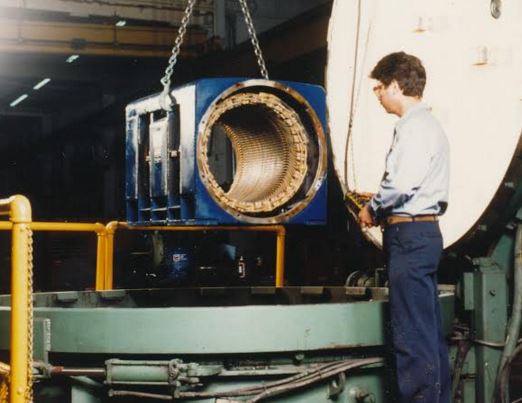Insulating Electric Motors: VPI or Varnish Dip?
May 19, 2016
VPI (Vacuum Pressure Impregnation) is a process that is a technological step forward from varnishing electric motors. The old dip and bake (in varnish) method of “insulating” motors is replaced by the VPI process for specific reasons:
- Harsh Environment
- Improved Efficiency (through better heat transfer)
- Improved Mechanical Winding Design
When electric motor repairs proceed as normal, a special VPI insulation system is used on the coils in place of standard insulation. The (preheated) Stator or Rotor is lowered into the VPI pressure chamber and a vacuum is drawn. A resin with 0% solvents is entered into the chamber, pressure is applied, then the submerged unit becomes entirely impregnated with resin creating a virtually “void free” insulation system.
This “void free” insulation system drastically reduces motor failure for three reasons:
- VPI reduces coil vibration
Historically, the singular most important cause of winding failure has been abrasion of either the ground or turn insulation. Vibration produced by the electro-magnetic forces acting on the windings causes wear or chaffing of the insulation when the windings move relative to the laminations, surge rings, ties, tieblocks, etc. As the insulation wears away, a point is reached where it can no longer withstand the voltage stress and a failure to ground occurs.
Equally serious is the flexing of the windings that can cause the insulated turns to short and bind together. Again, the insulation is abraded or worn away until failure occurs, causing a turn to turn motor failure.
The resin serves as an adhesive between the strands and turns. This causes the winding to be much stiffer, the same as a sheet of finished plywood is much stiffer than the unbonded layers of wood.
- VPI increases contamination resistance
Conductive contamination in the winding’s environment can penetrate small openings in the unsealed insulation and produce a conducting path between turns or to-ground. The VPI process does an excellent job of sealing off these openings and significantly reduces failure of this type.
- VPI improves heat transfer
The heat generated by the losses in the windings must be effectively dissipated if operating temperatures are to be controlled within acceptable limits. VPI treated windings have good heat transfer characteristics because the resin fills the voids between the conductors and the insulation (replacing the air), and between the insulation and the laminations.
This helps prevent degeneration of the insulating material due to exposure to excessive temperatures. The operating temperatures of windings not previously given a VPI treatment often can be significantly reduced when VPI treatment is provided as part of an electric motor rewinding.
Conversely, windings that were designed to take advantage of the better heat transfer provided by VPI may operate significantly hotter if VPI is not provided as part of the rewind procedure.
Another benefit of the void-free insulation structure produced by VPI: the lack of voids reduces the possibility of damage due to internal partial discharge (PD Activity) on high voltage windings.
By incorporating VPI and letting the motor run cooler, these three major causes of failures can be greatly reduced, thus reducing costly down time and energy consumption.
Questions about VPI?
HECO can help you with any questions you may have about using a void-free, VPI treatment to insulate your electric motors. We’ll begin by asking “Why?” Why is your current insulation process causing a problem? How often are you seeing failures? On what kinds of motors?
Then we’ll use our problem solving and engineering expertise to provide a VPI program tailored to your specific needs.
Posted in Equipment Management
